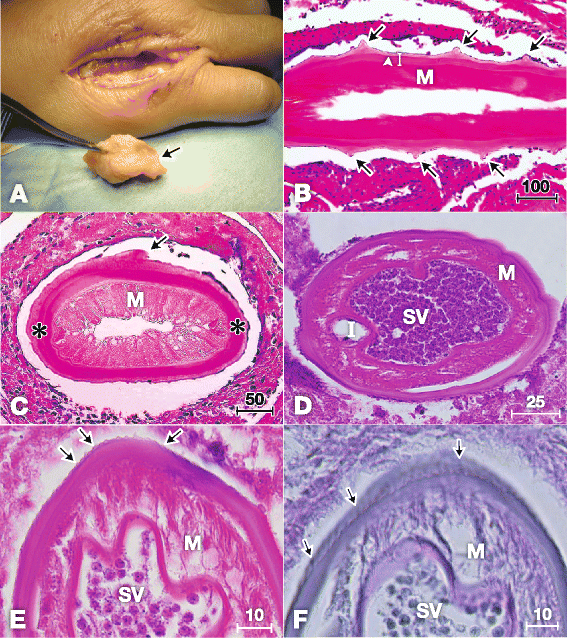New zoonotic cases of Onchocerca dewittei japonica (Nematoda: Onchocercidae) in Honshu, Japan
- PMID: 25623081
- PMCID: PMC4323255
- DOI: 10.1186/s13071-015-0655-2
New zoonotic cases of Onchocerca dewittei japonica (Nematoda: Onchocercidae) in Honshu, Japan
Abstract
Background: Zoonotic infections with Onchocerca species are uncommon, and to date only 25 clinical cases have been reported worldwide. In Japan, five previous zoonotic infections were concentrated in Oita, Kyushu (the southern island), with one previous case in Hiroshima in the western part of Honshu (the main island). The causative agent in Japan was identified as Onchocerca dewittei japonica Uni, Bain & Takaoka, 2001 from Japanese wild boars (Sus scrofa leucomystax Temminck, 1842). Here we report two infections caused by a female and male O. dewittei japonica, respectively, among residents of Hiroshima and Shimane Prefectures in the western part of Honshu.
Methods: In both cases, nodules were surgically removed. The parasites in nodules were identified on the basis of their histopathological characteristics. Identification was confirmed by sequencing the mitochondrial cytochrome c oxidase subunit 1 (cox1) gene from worms in the tissues used in the histological preparations.
Results: Case 1 was a 61-year-old woman from Hiroshima Prefecture who complained of a painful subcutaneous nodule on the back of her right hand. The causative agent was identified as a female O. dewittei japonica owing to transverse ridges on the cuticle and molecular analysis. Case 2 was a 78-year-old woman from Shimane Prefecture who had a painful nodule in the left temporal region. Histopathological characteristics and cox1 sequencing of the worm indicated that the causative agent was a male O. dewittei japonica.
Conclusions: For Cases 1 and 2, we diagnosed the causative agents as a female and male O. dewittei japonica, respectively. These findings indicate the spread of a zoonosis caused by O. dewittei japonica in the western part of Honshu, where wild boars have recently extended their habitats because of decreased annual snowfall, unused rice fields and a decline in the number of hunters in Japan. The O. dewittei japonica infection rate among wild boars was reported as 78% in Shimane Prefecture, in the western part of Honshu. Therefore, in the near future, zoonotic onchocercosis is likely to occur in Honshu as well as Kyushu, where wild boars, blackfly vectors and humans share the same habitat.
Figures



References
Publication types
MeSH terms
LinkOut - more resources
Full Text Sources
Other Literature Sources
Medical

